The
Analytics page provides a breakdown of incidents by severity and category, allowing you to focus on incidents of interest, for which they can view details. For any given incident, you can view the severity, client impact, root cause, and recommendations, as well as the events, anomalies, data, or problems that were used to identify the incident.
Figure 139
Analytics Page
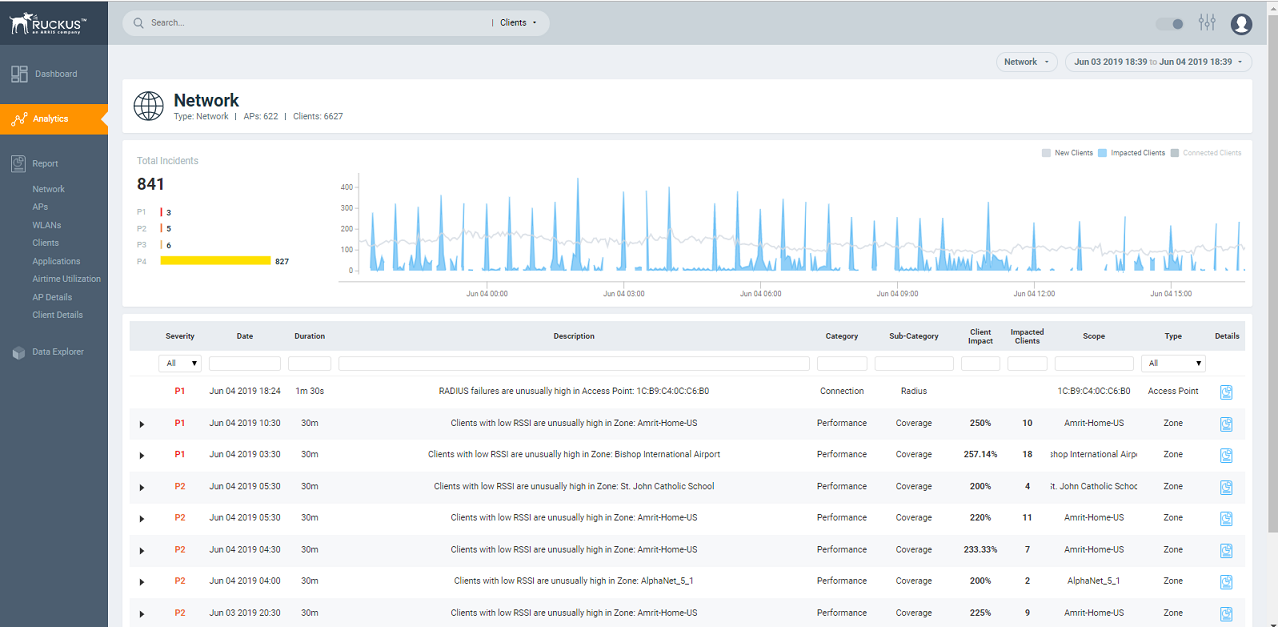
The analytics page consists of different sections which are described as follows:
The Analytics page contains a number of components:
- Network Filter menu
- Date and Time filter
- Network Node Details tile
- Severity Filter tile
- Incident Timeline
- Incident List table
- Incident Details
- Network Impact tile
- Insights
- Incident Info tile
Network Filter Menu
Click the
Network menu to select a network node within the circle packing representation. By default,
Network is selected, which displays a circle packing view of all the systems in the network. A network node can be a Venue, AP group, or access point in the network. After selecting a node, click X to close the circle packing representation.
Figure 140
Nodes on the Network
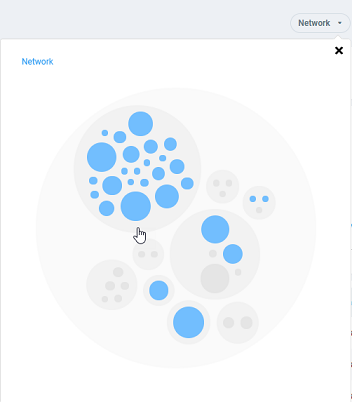
Date and Time Filter
The date and time filter is used to plot the date and time for a specific time period, including such as
Today,
Last 24 hours,
Last 7 days, or
Last Month.Use the Custom option to select the dates and times for a specific customized time period.
Figure 141
Custom Mode
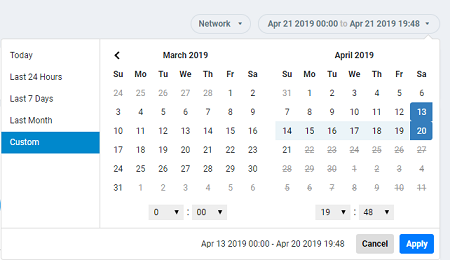
Click
Apply to save the specified date and time filters and update the Analytics page.
Network Node Details
The Network Node Details tile displays the name of the selected node from the
Network Filter menu as a header.
For example, the following figure shows the Density network node and its attributes (Type, APs, and Clients).
Figure 142
Density Network Node

The following table lists the various network nodes and their attributes.
Table 15 Network Nodes and Attributes
| Node
|
Attributes
|
| Network
|
- Type: Network
- AP Count
- Client Count
|
| AP Group
|
- Type: AP Group
- Zone Firmware
- AP Count
- Client Count
|
| AP
|
- Type Access point
- AP Firmware
- AP Name
- Model
- MAC Address
- IP Address
- Client
|
| Client
|
- Type: Client
- MAC Address
- Last IP Address
- OS Type
- Hostname
- Username
|
Severity Filter
The severity filter tallies the total number of incidents on the network node, and lists the number of incidents by severity.
Figure 143
Severity Filter
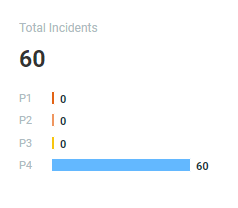
Incident Timeline
The Incident Timberline is a graphical representation of the number of new clients connecting to the network (the light gray line), the number of clients actively connected to the network (the dark gray line) and the number of clients affected by the network incidents (the blue area in the chart).
Figure 144
Incident Timberline

Pausing the pointer at any instance on the timeline displays an information box that shows the number of new clients, impacted clients, and connected clients. You can modify the information displayed in the information box by selecting the
New Clients, Impacted Clients, and
Connected Clients check boxes.
NOTE
On computers running Windows, press
Ctrl and rotate the wheel button to zoom in and zoom out of the Incident Timeline.
Incidents List Table
The Incidents List table offers a summary of each incident.
Figure 145
Incidents List Table
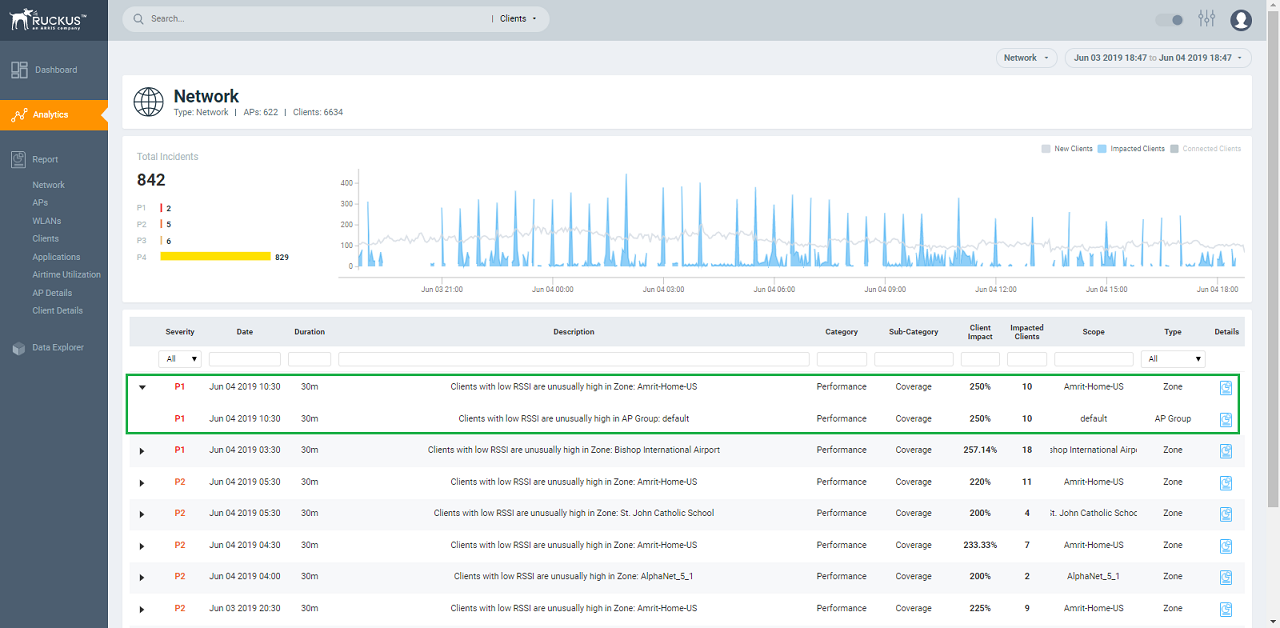
Each incident is made up of a number of attributes. Under each attribute is a search field to limit the incident list based on the search criteria. Click the right arrow button to view more information about other incidents that contribute to the selected incident and information about the parent incident to which the selected incident contributes.
Table 16 Attributes of the Incidents List Table
|
Attribute
|
Description
|
|
Severity
|
The severity of an incident ranges from P1 to P4; P1 being the highest priority and P4 the lowest. The severity of an incident is determined by the client impact, duration, and other factors. You can see the severity score when you hover the mouse over the number. The severity score of the incident takes into account the scope of the incident, duration of the incident, and the severity of the incident; giving equal consideration to all the mentioned parameters to arrive at the severity score.
|
|
Date
|
The date and time when the incident started.
|
|
Duration
|
The measure of how long the incident lasted.
|
|
Description
|
A short description of the incident. Pausing the pointer over the description displays more information about the incident.
|
|
Category
|
The type of incident, for example: Connection, Performance, and Infrastructure.
|
|
Sub-Category
|
Connection incidents consist of the following categories:
- Association
- User Authentication
- DHCP
- EAP
- RADIUS
- Time to Connect
Performance incidents consist of the following categories:
|
|
Client Impact
|
The percentage of clients impacted by the incident.
|
|
Impacted Clients
|
The number of clients impacted by the incident.
|
|
Type
|
The type of incident that occurred. You can view this by selecting the options from the drop-down menu. Options include Venues, AP Group and Access Point.
|
|
Scope
|
The area of the network in which the incident was detected. Pausing the pointer over the scope displays the entire path of the network node.
|
|
Details
|
Clicking the Details icon displays the
Incident details page to find more details about the incident such as impacted areas, root cause, and recommendations.
|
Incident Details Page
The header of the
Incident details page displays the severity level of a selected incident and the description of the incident.
Figure 146
Incident Details Page

You can also fix the thresholds for health parameters using the
Set Threshold option to validate the health of your network. Clicking
Set Threshold takes you to the
Health page where you can set the threshold for a parameter. For instance, if you set the threshold for the Time to Connect (TTC) parameter as 2 seconds, the TTC graph displays the number of connections that are able to connect to the network within 2 seconds. It also displays the average time to connect to the network in general, and the total connections attempting to connect to the network. Every time a new threshold is set, the graph trends simultaneously change as the computing changes. Similarly, thresholds can be set for various parameters to evaluate network health such as ROSSI, AP Capacity, AP Service Uptime, AP-to-Cloud Service Latency, and Cluster Latency. The threshold will apply tot he incident related to the metric.
Network Impact Tile
The Network Impact tile consists of various donut charts that represent the areas of the network that were impacted by the incident. Each incident type and subtype has a different set of network impact donut charts, but it is common to see WLANs, Client OS Types, AP Models, Radio Bands, and Reason Codes, which all help to explain some of the common questions: who is impacted, which devices are contributing, what are the reason codes, and more. Every donut chart is divided into donut charts of different colors. If you pause the pointer over any portion of the donut chart, an information box displays the impacted area of the incident and the clients affected by this the incident. Beneath each donut chart is a summary line Two donut charts are shown by default. You can click the right arrow and left arrow to navigate to other donut charts, or click Radio, WLAN, Client Manufacturers, or Reason to access a specific donut chart.
Figure 147
Network Impact Tile

Table 17 Attributes of Network Impact Table
| Incident Type
|
Donut Charts
|
Chart Elements
|
| User Authentication
|
- Radio: The distribution of impacted clients who connected to 5 GHz and 2.4 GHz radios.
- WLAN: The different WLANs to which the impacted clients are connected.
- Client Manufactures: The distribution of device manufacturers.
- Reason: The breakdown of various failure reasons experienced by the impacted clients.
.
|
- Authentication Failure Ratio: A time series chart that shows the failure ratio over time. The chart includes data for 6 hours before and 6 hours after (if available) the incident.
- Clients: Three types of time series data: a line for new clients, a line for connected clients, and an area chart for impacted clients.
- Failure counts: A time series chart with three types of raw failure counts: Authentication Failures, Authentication Attempts, and Total Failures, which includes the total of all types of connection failures (authentication, association, EAP, DHCP, and so on) that were observed during this period.
|
| EAP
|
- Radio: The distribution of impacted clients who connected to 5 GHz and 2.4 GHz radios.
- WLAN: The different WLANs to which the impacted clients are connected.
- Client Manufactures: The distribution of device manufacturers.
- Reason: The breakdown of various failure reasons experienced by the impacted clients.
|
- EAP Failure Ratio: A time series chart that shows the failure ratio over time. The chart includes data for 6 hours before and 6 hours after (if available) the incident.
- Clients: Three types of time series data: a line for new clients, a line for connected clients, and an area chart for impacted clients.
- Failure counts: A time series chart with three types of raw failure counts: EAP Failures, EAP Attempts, and Total Failures, which includes the total of all types of connection failures (authentication, association, EAP, DHCP, and so on) that were observed during this period.
|
| Association
|
- Radio: The distribution of impacted clients who connected to 5 GHz and 2.4 GHz radios.
- WLAN: The different WLANs to which the impacted clients are connected.
- Client Manufactures: The distribution of device manufacturers.
- Reason: The breakdown of various failure reasons experienced by the impacted clients.
|
- Association Failure Ratio: A time series chart that shows the failure ratio over time. The chart includes data for 6 hours before and 6 hours after (if available) the incident.
- Clients: Three types of time series data: a line for new clients, a line for connected clients, and an area chart for impacted clients.
- Failure counts: A time series chart with three types of raw failure counts: Association Failures, Association Attempts, and Total Failures, which includes the total of all types of connection failures (authentication, association, EAP, DHCP, and so on) that were observed during this period.
|
| DHCP
|
- Radio: The distribution of impacted clients who connected to 5 GHz and 2.4 GHz radios.
- WLAN: The different WLANs to which the impacted clients are connected.
- Clients Manufactures: The distribution of device manufacturers.
- Reason: The breakdown of various failure reasons experienced by the impacted clients.
|
- DHCP Failure Ratio: A time series chart that shows the failure ratio over time. The chart includes data for 6 hours before and 6 hours after (if available) the incident.
- Clients: Three types of time series data: a line for new clients, a line for connected clients, and an area chart for impacted clients.
- Failure counts: A time series chart with three types of raw failure counts: DHCP Failures, DHCP Attempts, and Total Failures, which includes the total of all types of connection failures (authentication, association, EAP, DHCP, and so on) that were observed during this period.
|
| RADIUS
|
- Radio: The distribution of impacted clients who connected to 5 GHz and 2.4 GHz radios.
- WLAN: The different WLANs to which the impacted clients are connected.
- Client Manufactures: The distribution of device manufacturers.
- Reason: The breakdown of various failure reasons experienced by the impacted clients.
|
- Radius Failure Ratio: A time series chart that shows the failure ratio over time. The chart includes data for 6 hours before and 6 hours after (if available) the incident.
- Clients: Three types of time series data: a line for new clients, a line for connected clients, and an area chart for impacted clients.
- Failure counts: A time series chart with three types of raw failure counts: RADIUS Failures, RADIUS Attempts, and Total Failures, which includes the total of all types of connection failures (authentication, association, EAP, DHCP, and so on.) that were observed during this period.
|
| Time to Connect
|
- Radio: The distribution of impacted clients who connected to 5 GHz and 2.4 GHz radios.
- WLAN: The different WLANs to which the impacted clients are connected.
- Client Manufactures: The distribution of device manufacturers.
- Reason: The breakdown of various failure reasons experienced by the impacted clients.
|
- Time to Connect Failure Ratio: A time series chart that shows the failure ratio over time. The chart includes data for 6 hours before and 6 hours after (if available) the incident.
- EAP Failure Ratio: A time series chart that shows the failure ratio over time. The chart includes data for 6 hours before and 6 hours after (if available) the incident.
- Clients: Three types of time series data: a line for new clients, a line for connected clients, and an area chart for impacted clients.
- Failure counts: A time series chart with three types of raw failure counts: Time to Connect Failures, Time to Connect Attempts, and Total Failures, which includes the total of all types of connection failures (authentication, association, EAP, DHCP, and so on) that were observed during this period.
|
| RSSI
|
- Radio: The distribution of impacted clients who connected to 5 GHz and 2.4 GHz radios
- WLAN: The different WLANs to which the impacted clients are connected.
- Client Manufactures: The distribution of device manufacturers.
- Reason: The breakdown of various failure reasons experienced by the impacted clients.
|
- RSSI Quality by Clients: Three types of time series data: a line for new clients, a line for connected clients, and an area chart for impacted clients.
- RSSI Distribution: The RSSI distribution over a period of time.
|
|
Network Latency
|
|
- Ping Latency: Average time, in milliseconds, for the controller nodes to transmit and receive the packets. Maximum, average, and minimum latency trends are plotted on the graph.
- Controller-1: CPU, memory and input-output usage of the controller node over time is displayed.
- Controller-2: CPU, memory and input-output usage of the other controller node over time is displayed.
|
Insights Tile
The Insight tile of the
Incident Details page provides a summary of the root cause and recommended action for the incident. The root cause varies based on the incident type, impacted area, data events, and reason codes.
Figure 148
Insights Tile
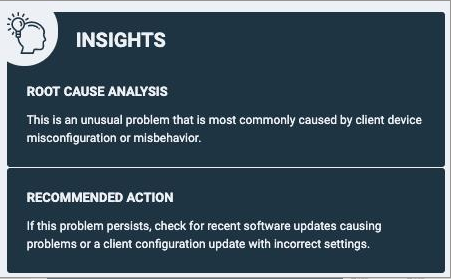
Incident Info Tile
The
Incident Info tile lets you know the client impact count, the category and sub-category of the incident, the type, scope, duration, and date and time of the incident.. To explore more about the impacted clients, click
Client Impact Count.
Figure 149
Incident Info Tile
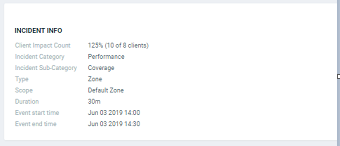
The
Impacted Clients page displays the user name, host name, client MAC address, SSID, and manufacturer of the client. To troubleshoot the client, click the Client Troubleshooting icon ( ), or to generate the client details report, click the Client Details icon (
), or to generate the client details report, click the Client Details icon ( ) on the
Impacted Clients page. You can search for impacted clients by the client MAC address and manufacturer.
) on the
Impacted Clients page. You can search for impacted clients by the client MAC address and manufacturer.
Figure 150
Clients page
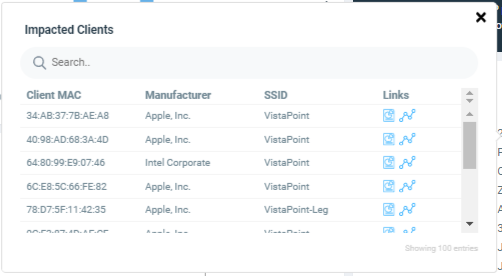











 ), or to generate the client details report, click the Client Details icon (
), or to generate the client details report, click the Client Details icon ( ) on the
Impacted Clients page. You can search for impacted clients by the client MAC address and manufacturer.
) on the
Impacted Clients page. You can search for impacted clients by the client MAC address and manufacturer.

